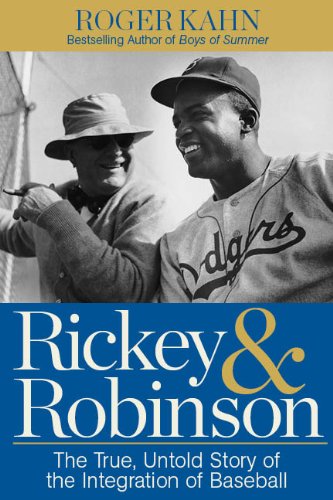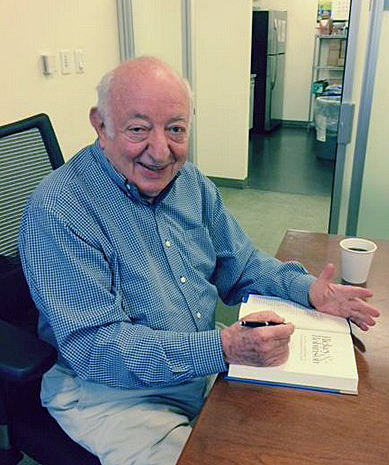Everyone knows that Jackie Robinson was the first African-American in modern Major League Baseball – we’ve heard about it our entire lives, we learned about it in school, we’ve read countless articles and books about it and we’ve even seen a recent (and excellent) motion picture by Academy Award-winning writer/director Brian Helgeland titled 42 about it. (If you haven’t seen the movie you really need to). But what very few people realize is that Helgeland’s movie could have very easily been titled 36 after legendary Dodgers pitcher Don Newcombe.
Sam Lacy* said Jackie Robinson was not the best Negro League player in 1945. “Not the best,” Lacy repeated, “but the most suitable.” Buzzie Bavasi told me “The Negro League player with the most talent was Don Newcombe. But Mr. Rickey wouldn’t sign him to be the first because Newcombe was 19 years old. He felt that Newk was too young to face the pressure we knew was coming.” Such comments created a general underestimation of Robinson’s pure athletic ability.
It is facts such as this that fill the pages of Roger Kahn’s new book Rickey & Robinson – The True, Untold Story of the Integration of Baseball, which hits book stores (and eBook stores) on Tuesday, September 16.

Rickey & Robinson – The True, Untold Story of the Integration of Baseball is bestselling author Roger Kahn’s 20th and final book.
(Image courtesy of Rodale Books)
If you are a true baseball fan, especially a Dodger fan, the name Roger Kahn should be familiar to you. Kahn is the author of the 1972 bestselling book The Boys of Summer, which is still considered to be one of the best sports books of all time.
Kahn, who has a very unique and captivating writing style (as evidenced in the 20 books that he has now authored), is the last known living sportswriter/author who was actually there during one of baseball’s (and our country’s) greatest moments – the integration of blacks into Major League Baseball. But the true Jackie Robinson/Branch Rickey story, according to 86-year-old Kahn, was often times tumultuous at best – not between the two of them but between them and the rest of baseball.
On September 23, 1997, Kahn attended an event in Princeton, New Jersey called “Remembering Branch Rickey.” Among those in attendance was Branch B. Rickey, Branch Rickey’s grandson, who spoke about a private meeting between baseball owners and executives that reportedly took place in 1945 – a meeting which some later denied ever happened. Kahn writes:
The most passionate speaker turned out to be Branch B. After his grandfather moved to break the big-league color line, Branch B. said, the other owners gathered in a secret meeting and denounced him. According to young Branch, the rival magnates stormed about and shouted that integration could very well destroy baseball. Talk about slash and burn. “To a man,” young Branch said, in ringing tones, “everyone in the room condemned my grandfather. No other owner, not a single one, stood up for him. Among men he thought were colleagues and friends, my grandfather found himself utterly and completely alone.”
When the Princeton proceedings ended, Branch and I eased back with a few drinks at the Nassau Inn, a Princeton tavern that dates from 1756, when Princeton was a mostly Quaker town, a small colonial landmark between New Brunswick and Trenton. I asked where he had heard about the meeting that so roundly condemned his grandfather. “From my grandfather himself,” Branch said. “He spoke about it more than once.”
Kahn’s new book, which he says will be his last, not only details one of our country’s most important events, it is also loaded with great first-hand stories about both the Brooklyn and Los Angeles Dodgers – many of which are completely unknown to all but the most serious of Dodgers history buffs.
Now word spread through baseball about the Brooklyn kid with the blazer. Koufax tried out for the Giants at the Polo Grounds but later said he was so nervous he forgot to bring his glove. He was wild and the Giants took a pass. Then he traveled to Forbes Field, where Rickey [then general manager of the Pittsburgh Pirates] watched with his favorite scout, Clyde Sukeforth. Another Rickey favorite, a former Cardinal catcher named Sam Narron, crouched behind the plate. Koufax threw harder and harder until a fastball finally broke Sam Narron’s thumb – a thumb that was protected by a catcher’s mitt. Rickey said quietly to Sukeforth, “This is the finest arm I’ve ever seen.” After a bit Sukeforth told Koufax Mr. Rickey is thinking of a generous signing package. Something like $15,000.
The Ice Cream League star said he would have to think about it. He went back to Brooklyn and tried out for the Dodgers at Ebbets Field. Al Campanis, then the Dodgers’ chief scout, took a stance in the batter’s box when Koufax was ready to pitch. He memorably described what happened next. “Only twice in my life,” Campanis told me, “has the hair on the back of my neck literally stood up straight. The first time was when I saw Michelangelo’s Sistine Chapel. The second time was when I saw Sandy Koufax’s fastball.”
Can you even imagine? Koufax a Pirate, or worse – a Giant? Unthinkable.
Kahn even includes a brief bit about disgraced former Dodgers owner Frank McCourt in Rickey & Robinson – and he pulls no punches on his feelings about McCourt.
As commissioner, [Kenesaw Mountain] Landis kept files on Durocher, but he was most active in 1943 considering the now forgotten case of a lumber millionaire named William D. Cox, principal owner of the Phillies, who stood accused of betting on ballgames. He bet on the Phillies, not against them, but any baseball gambling by an owner violated the game’s prime directive: Do not bet! Landis found the charges valid and ruled sternly on Cox. “You are hereby declared ineligible to hold any office or employment with the Philadelphia National League Club, or any club or league party to the Major-Minor Agreement.” (This was decidedly more draconian than commissioner Allan “Bud” Selig’s 2011 action deposing Fastbuck Frank McCourt as CEO of the Dodgers. The charge against Frankie Fastbuck was not gambling, but overall fiscal irresponsibility, spelled greed, which contributed to his mismanagement of what had been a gorgeous ballpark in the center of what was once a golden franchise. Unlike McCourt, Cox, a Yale graduate, went quietly. After no more than token resistance, he broadcast a farewell on a popular New York radio station, WOR. Cox concluded, “Good luck and goodbye to everyone in baseball.”)
As you can see from these short excerpts from Rickey & Robinson, there is a great deal about these two American heroes that we do not know that Kahn reveals to us – along with many other great baseball stories and facts. They are presented in a manner that we have come to know and enjoy from Kahn. The book is well written and easy to read.
Rickey & Robinson – The True, Untold Story of the Integration of Baseball is a must-read for baseball fans who thrive on baseball history or who want to know more about the behind-the-scene dealings that brought us one of the greatest and most important baseball players in history.
* * * * * * * *
*Sam Lacy was a black sportswriter for for a chain of Afro-American weekly newspapers. In 1948 he became the first black member of the Baseball Writers’ Association of America and was inducted into the writers’ wing of the National Baseball Hall of Fame in 1997.




 September 12th, 2014 at 6:00 am
September 12th, 2014 at 6:00 am  by Ron Cervenka
by Ron Cervenka 
 Posted in
Posted in 

RT @Think_BlueLA: ‘Rickey & Robinson’ reveals many unknown facts about the integration of baseball – http://t.co/lORVsSpmcP #Dodgers @Rodal…
@Think_BlueLA says Roger Kahn’s Rickey & Robinson is “a must-read for baseball fans who thrive on baseball history”: http://t.co/fL9XfJVzZn
Thanks, Ron. I’ve ordered the book, can’t wait to start reading!
‘Rickey & Robinson’ reveals many unknown facts about the integration of baseball, by @IBWAA member @Think_BlueLA. http://t.co/XoVt9CYCkj
RT @IBWAA: ‘Rickey & Robinson’ reveals many unknown facts about the integration of baseball, by @IBWAA member @Think_BlueLA. http://t.co/Xo…
ICYMI: New ‘Rickey & Robinson’ book reveals unknown facts about integration of baseball – http://t.co/KRVg8w2RC9 #Dodgers
@Think_BlueLA Wow thanks!! I just ordered the book, and another Dodgers book to get free shipping. “Boys of Summer” is my favorite book!!
RT @Think_BlueLA: Roger Kahn’s new book ‘Rickey & Robinson’ hits book stores today. It’s a must-read book for every baseball fan – http://t…
[…] This comes from a non-mainstream source – Dodger-centric blog — so I don’t know the age of the writer. Could be that this is revelatory information to him.The same could be said about this one from The Baseball Historian blog. […]